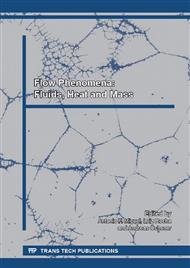p.73
p.88
p.97
p.118
p.126
p.135
p.144
p.151
p.157
Thermofluidodynamic Evaluation of Oil-Water Flow in the Presence of a Leak in Curved Connection: Modeling and Simulation
Abstract:
Oil transport is used mainly by pipeline networks to transport oil from refineries and distributions points to the consumers. This is the main way to transport oils especially in areas of difficult access, ensuring efficiency, lowest cost and safety. In the chemical and petroleum industry it is possible to observe the presence of leak in the pipes, which has stimulated the development of reliable techniques for the rapid and accurate detection of leaks along the pipe in order to eliminate or minimize loss and environmental damage. In this context, this study aims to evaluate the effect of the numerical presence of leakage of two-phase flow (oil-water) pipe connections using the commercial software ANSYS CFX. The results from the fields of pressure, velocity and volume fraction are presented and assessed for illustrating the effect of the presence of the leak in the dynamic flow in the pipe with a curved connection.
Info:
Periodical:
Pages:
126-134
Citation:
Online since:
April 2016
Keywords:
Price:
Сopyright:
© 2016 Trans Tech Publications Ltd. All Rights Reserved
Share:
Citation:


